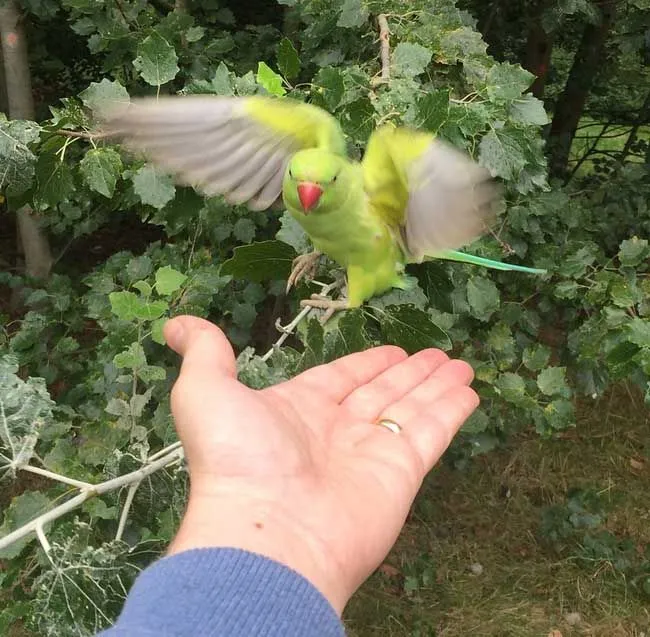FOR ALL AGES
Ever noticed a green flash among the trees? You probably saw a parakeet.
Britain is now home to around 10,000 breeding pairs, with huge colonies in London and the south-east. Spotting the charismatic birds is a fun and rewarding activity for families. They are very easy to identify, and seem to have little fear of humans.
Here’s our guide to taking the children to see wild parakeets.
Nobody knows. Their origins are mysterious. Large flocks have been around since the 1990s, but smaller groups were reported for decades before that.
The ring-necked parakeet (which is what we’re dealing with) originates in India and parts of Africa. The bird has been kept as a pet for centuries, but only recently established itself as a wild population in the UK.
The many theories are as exotic as the birds themselves. Jimi Hendrix is said to have released a breeding pair on Carnaby Street in the swinging '60s (he didn’t). Others escaped from the set of The African Queen, filmed in Isleworth in 1951 (they didn’t). A recently invented urban myth pins the blame on George Michael, whose collection of exotic birds escaped in the 1990s (again, they didn’t). Others blame the Great Storm of 1987 for rattling up the aviaries, or just the gradual, individual release of numerous pets over the years. Or maybe they just flew here. Nobody knows, really.

No. It’s a doddle. Just look for a green bird about the size of a pigeon. There’s not much else that could fit the description -- other than a green woodpecker, which is less showy and doesn’t hang around in flocks. Plus, they squawk like billy-o. You often hear them before you see them. In fact, by coincidence, I can hear one out of the window as I type this sentence.
Very. Especially in London and the south-east. You know, it’s remarkable how many people are still unaware of the birds. Once you’re clued on, you’ll spot a few every time you go out for a walk. Kids have a particular knack of spotting them.
The large parks of south and west London are a pretty safe bet. Huge flocks screech their way around Richmond and Bushy Park, for example (you can also look out for deer while you’re there).
The Royal Parks in central London are also a popular parakeet playground. I’ve found that Kensington Gardens has the tamest birds. The most tame are often found near the Peter Pan statue -- appropriate really, given Peter’s associations with pirates and therefore parrots. These ones are so tame, that they’ll readily land on your outstretched arm -- especially if you hold an apple. Here’s proof. This is me

Just be careful with small children, as the birds’ claws are a little scratchy.
Although London is considered their stronghold, flocks of parakeets have been recorded in almost every English and Welsh county. The Home Counties are most bounteous, but you may have joy almost anywhere.
It depends who you ask. Some people consider them invasive pests, who push out smaller birds and reduce the food supply for other animals. And that piercing squawk isn’t easy to love -- especially if you live near a roosting site. But others -- especially children -- adore the brightly coloured birds for adding a splash of the exotic to our parks and gardens. Happy spotting!
All images by the author.
Read The Disclaimer
At Kidadl we pride ourselves on offering families original ideas to make the most of time spent together at home or out and about, wherever you are in the world. We strive to recommend the very best things that are suggested by our community and are things we would do ourselves - our aim is to be the trusted friend to parents.
We try our very best, but cannot guarantee perfection. We will always aim to give you accurate information at the date of publication - however, information does change, so it’s important you do your own research, double-check and make the decision that is right for your family.
Kidadl provides inspiration to entertain and educate your children. We recognise that not all activities and ideas are appropriate and suitable for all children and families or in all circumstances. Our recommended activities are based on age but these are a guide. We recommend that these ideas are used as inspiration, that ideas are undertaken with appropriate adult supervision, and that each adult uses their own discretion and knowledge of their children to consider the safety and suitability.
Kidadl cannot accept liability for the execution of these ideas, and parental supervision is advised at all times, as safety is paramount. Anyone using the information provided by Kidadl does so at their own risk and we can not accept liability if things go wrong.
Kidadl is independent and to make our service free to you the reader we are supported by advertising.
We hope you love our recommendations for products and services! What we suggest is selected independently by the Kidadl team. If you purchase using the buy now button we may earn a small commission. This does not influence our choices. Please note: prices are correct and items are available at the time the article was published.
Kidadl has a number of affiliate partners that we work with including Amazon. Please note that Kidadl is a participant in the Amazon Services LLC Associates Program, an affiliate advertising program designed to provide a means for sites to earn advertising fees by advertising and linking to amazon.
We also link to other websites, but are not responsible for their content.
Was this article helpful?



Browse Category



We’ll send you tons of inspiration to help you find a hidden gem in your local area or plan a big day out.



Check your inbox for your latest news from us. You have subscribed to:
Remember that you can always manage your preferences or unsubscribe through the link at the foot of each newsletter.